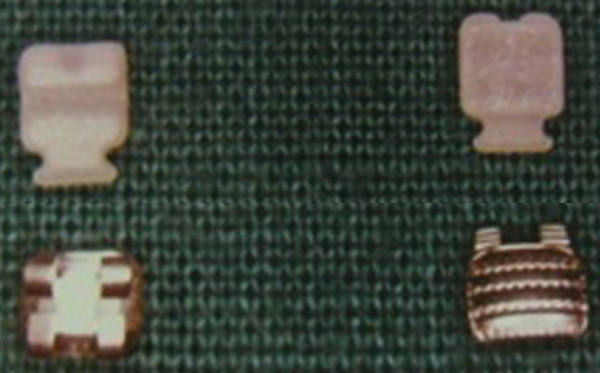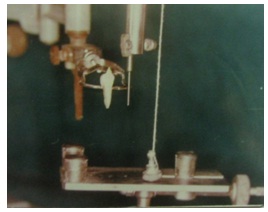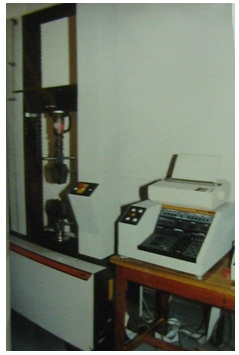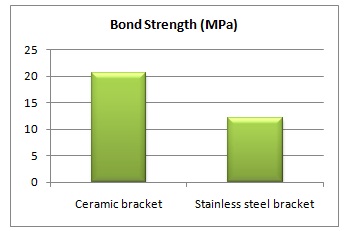The Shear Bond Strengths of Metal and Ceramic Brackets: An in-Vitro Comparative Study
Y G Reddy1, Rohit Sharma2, Ammandeep Singh3, Vishal Agrawal4, Vijay Agrawal5, Saurab Chaturvedi6
1 Professor & Head, Department of Orthodontics & Dentofacial Orthopedics, NIMS Dental College and Hospital, Jaipur, Rajasthan, India.
2 Reader, Department of Oral Medicine & Radiology, NIMS Dental College & Hospital, Jaipur, Rajasthan, India.
3 Reader, Department of Community & Public Health Dentistry, NIMS Dental College and Hospital, Jaipur, Rajasthan, India.
4 Professor and Head, Department of Conservative Dentistry, NIMS Dental College and Hospital, Jaipur, Rajasthan, India.
5 Reader, Department of Orthodontics, NIMS Dental College & Hospital, Jaipur, Rajasthan, India.
6 Senior Lecturer, Department of Orthodontics & Dentofacial Orthopedics, NIMS Dental College and Hospital, Jaipur, Rajasthan, India.
Name, Address, E-Mail Id of The Corresponding Author: Dr Rohit Sharma, 13, Govardhan Colony, New Sanghaner Road, Behind Central Bank, Sodala, Jaipur, Rajasthan, India.
Phone: 0141-2290295, 09799568676
E-mail: rohitsharmasam@yahoo.co.in
Aim: This study has compared the Shear Bond Strengths (SBSs) of ceramic brackets and metal brackets.
Materials and Method: Forty freshly extracted, human maxillary first premolars were selected for bonding. They were equally bonded with ceramic brackets (Transcend series 6000) and metal brackets (Mini Dynalock Straight wire brackets). A no – mix orthodontic adhesive system was used. Their shear bond strengths were measured by using the Instron universal machine.
Results: The mean bond strength of the ceramic brackets was 20.68 ± 3.89 Mpa and that of the metal brackets was 12.15 ± 1.32 MPa.
Conclusion: The shear bond strength of the ceramic brackets was found to be superior than that of the metal brackets.
Bracket,Ceramic,Metal,Shear bond
Introduction
Aesthetic orthodontic appliances have been in demand for adult patients in the recent years [1]. Ceramic orthodontics brackets were introduced in 1987 as a more aesthetically pleasing alternative to the stainless steel brackets [2]. Two types of ceramic brackets are currently available in the market, polycrystalline and monocrystalline (single-crystal) aluminas [3,4]. Ceramic brackets are also quite strong; they are more difficult to deform and have a higher tensile strength than the stainless steel brackets [5]. The bonding strength of ceramic brackets has been shown to be significantly higher than that of metal brackets. The high bond strength results from silanization of the bracket base, mechanical retention, or both [6,7]. The silane coupling agents have been reported to enhance the bond strength to the porcelain surfaces [8,9]. The silane reacts with the silica within the porcelain and the organic groups of the bonding resin, thus forming a bridge between the two materials [10]. In fact, orthodontists sometimes experience problems during debonding, when the bond is too strong to break [11].
The purpose of this study was to compare the shear bond strength of ceramic brackets and that of stainless steel brackets.
Material and Methods
Forty freshly extracted maxillary first premolars (they were extracted for therapeutic reasons), which were non carious without any cracks and were not fractured, were selected for this study. All the collected teeth were cleaned of blood and saliva and they were stored in a buffered saline solution at room temperature. They were divided into 2 groups of 20 teeth each. In Group A – Ceramic (Transcend series 6000, 3M Unitek) brackets were bonded and in Group B – Stainless steel (Mini Dynalock straight wire metal brackets, 3M Unitek) brackets were bonded [Table/Fig-1].
Brackets used in study. Group A: Transcend 6000 series ceramic bracket Group B: Mini Dynalock Straight wire metal brackets

The bonding procedure: All the extracted teeth were cleaned with a scaler and then with a fine pumice by using a rubber prophylaxis cup on a slow speed conventional hand piece (2000 – 5000 rpm). A 37% phosphoric acid solution was applied to each enamel surface with a disposable foam pellet, for 30 seconds. The teeth were than rinsed with a stream of water for 20 seconds and dried with oil free compressed air for 15 seconds.
A no-mix orthodontic adhesive system was used. The teeth were left at room temperature for 30 minutes to allow full polymerization of the adhesive (chemically activated resin) and they were then stored at room temperature in saline to prevent dehydration before they were tested. Each tooth was held in a mounting jig [Table/Fig-2]. An Instron universal machine was used to perform the debonding tests [Table/Fig-3]. The shear stress at the bond failure was recorded for each bracket and the bond strength was calculated. The statistical analysis of the findings was done and the standard deviation and mean were calculated. The Student’s ‘t’ test was used to compare the mean bond strengths of the two groups.
Mounting of specimen into jig

Instron universal machine to measure shear bond strength

Results
The shear bond strengths of the two groups have been shown in [Table/Fig-4] and [Table/Fig-5]. The mean SBS was significantly higher for the ceramic group (20.68 ± 3.89 MPa) as compared to that of the metal bracket group (12.15 ± 1.32 MPa). Student’s ‘t’ test [Table/Fig-6] and [Table/Fig-7] showed a significant difference in the mean shear bond strengths between the two groups (p < 0.05).
Bond strength of Ceramic brackets
| Sample No. | Breaking load (kg) | Bond Strength (kg/cm2) | Bond Strength (MPa) |
|---|
| 1. | 25.13 | 221.45 | 21.72 |
| 2. | 24.24 | 213.19 | 20.91 |
| 3. | 20.18 | 177.48 | 17.41 |
| 4. | 19.48 | 171.32 | 16.80 |
| 5. | 24.23 | 213.10 | 20.90 |
| 6. | 28.49 | 250.57 | 24.58 |
| 7. | 29.56 | 259.98 | 25.50 |
| 8. | 25.24 | 221.98 | 21.77 |
| 9. | 19.16 | 168.13 | 16.49 |
| 10. | 23.45 | 206.24 | 20.23 |
| 11. | 24.86 | 218.64 | 21.44 |
| 12. | 18.16 | 159.71 | 15.66 |
| 13. | 29.49 | 259.36 | 25.44 |
| 14. | 26.17 | 230.16 | 22.57 |
| 15. | 25.18 | 221.45 | 22.02 |
| 16. | 23.53 | 206.94 | 20.30 |
| 17. | 16.19 | 142.39 | 13.96 |
| 18. | 27.16 | 238.87 | 23.43 |
| 19. | 24.94 | 219.34 | 21.51 |
| 20. | 22.17 | 194.98 | 19.12 |
| Mean | 23.85 | 209.51 | 20.68 ± 3.89 |
Bond strength of Stainless steel brackets
| Sample No. | Breaking load (kg) | Bond Strength (kg/cm2) | Bond Strength (MPa) |
|---|
| 1. | 18.95 | 111.47 | 10.93 |
| 2. | 20.42 | 120.11 | 11.78 |
| 3. | 22.19 | 130.52 | 13.30 |
| 4. | 23.14 | 136.11 | 13.35 |
| 5. | 19.29 | 113.47 | 11.13 |
| 6. | 18.49 | 108.76 | 10.66 |
| 7. | 17.46 | 102.70 | 10.07 |
| 8. | 16.96 | 99.76 | 9.78 |
| 9. | 21.41 | 125.94 | 12.39 |
| 10. | 19.59 | 115.23 | 16.30 |
| 11. | 21.49 | 126.40 | 12.40 |
| 12. | 18.74 | 110.23 | 10.81 |
| 13. | 19.29 | 113.47 | 11.34 |
| 14. | 23.49 | 138.17 | 13.55 |
| 15. | 20.19 | 118.76 | 11.65 |
| 16. | 16.87 | 99.23 | 9.73 |
| 17. | 18.49 | 108.76 | 10.66 |
| 18. | 19.21 | 113.00 | 11.08 |
| 19. | 20.17 | 118.64 | 11.63 |
| 20. | 22.41 | 131.82 | 12.93 |
| Mean | 19.91 | 112.52 | 12.15 ± 1.32 |
Comparison between 2 groups (metal and ceramic brackets)
| S. No. | Comparison between groups | Calculative p-value | Result |
|---|
| 1. | Group A vs Group B | p< 0.05 | Significant |
Shear bond strength of ceramic and stainless steel bracke

Discussion
Aesthetic considerations are of key importance for the patients who undergo orthodontic treatment. Aesthetic orthodontic brackets have been developed to meet this demand of the patients. However, at the same time, other material properties such as the bond strength, the structural integrity, the bonding mechanism etc., have to be considered, in order to meet the clinical requirements.
Metal brackets, though they are aesthetically inferior to ceramic brackets, can be deformed considerably without fracturing, even in the presence of impurities and at sharp intersections [12]. They do not fracture under stress and are available at relatively low costs as compared to the ceramic brackets. Metal brackets, because of their comparative low bond strength, cause minimal enamel damage during debonding [5].
Ceramic brackets bond to the tooth surface by forming both mechanical and chemical bonds. Silanisation of the bracket because of the silane coupling agent is responsible for the chemical bond and it improves the bond strength. Because of a significant increase in the bond strength, the stress of debonding can also be shifted from the bracket – adhesive interface to the adhesive-enamel interface, which is likely to damage the enamel surface during the debonding procedure [13].
In the present study, the shear bond strengths of the ceramic brackets (Transcend series 6000) and the metal brackets (Mini Dynalock brackets) were compared. A minimum of 10 specimens is recommended to perform the SBS testing [14]. However, a sample size which is greater than 10 per group is recommended for the bond strength testing of natural teeth, where variations in the tooth shape exist [15]. The maxillary premolar teeth are the teeth which are most frequently extracted as an integral part of the orthodontic therapy. Therefore, the premolar tooth form was selected to allow a clinical simulation and to compare the outcome of the present study with those of previously reported investigations [9,11].
The mean SBS of the ceramic bracket group was found to be superior as compared to that of the metal bracket group. This finding was in agreement to those of previous studies [6,16,17].
In this study, the Transcend 6000 series ceramic brackets were used. These are different from the original transcend brackets in a very important aspect i.e. these brackets lack the silane primer on the base and therefore, they rely totally on the micromechanical retention. When the Transcend 6000 brackets were debonded, a majority of the adhesive remained on the tooth surface, thus assuring the highest level of protection on the tooth surface.
Conclusion
The Transcend 6000 series brackets are aesthetically superior and they provide a greater bond strength as compared to the metallic brackets.
[1]. Sinha PK, Nanda RS, Esthetic orthodontic appliances and bonding concerns for adults Dent Clin North Am 1997 Jan 41(1):89-109. [Google Scholar]
[2]. Birnie D, Ceramic brackets Br J Orthod 1990 17:71-75. [Google Scholar]
[3]. Bordeaux JM, Moore RN, Bagby MD, Comparative evaluation of ceramic bracket base designs Am J Orthod Dentofacial Orthop 1994 Jun 105(6):552-60. [Google Scholar]
[4]. Bishara SE, Feht DE, Ceramic brackets: something old, something new, a review Semin Orthod 1997 Sept 3(3):178-88. [Google Scholar]
[5]. Swartz ML, Ceramic brackets J Clin Orthod 1988 Feb 22(2):82-88. [Google Scholar]
[6]. Gwinnett AJ, A comparison of shear bond strengths of metal and ceramic brackets Am J Orthod Dentofacial Orthop 1988 Apr 93(4):346-48. [Google Scholar]
[7]. Joseph VP, Rossouw E, The shear bond strengths of stainless steel and ceramic brackets used with chemically and light-activated composite resins Am J Orthod Dentofacial Orthop 1990 Feb 97(2):121-25. [Google Scholar]
[8]. Bramble LM, A paradigm of the market place Am J Orthod Dentofacial Orthop 1988 Oct 94(4):354-55. [Google Scholar]
[9]. Kocadereli I, Canay S, Akça K, Tensile bond strength of ceramic orthodontic brackets bonded to porcelain surfaces Am J Orthod Dentofacial Orthop 2001 Jun 119(6):617-20. [Google Scholar]
[10]. Newman SM, Dressler KB, Grenadier MR, Direct bonding of orthodontic brackets to esthetic restorative materials using a silane Am J Orthod 1984 Dec 86(6):503-06. [Google Scholar]
[11]. Bourke BM, Rock WP, Factors affecting the shear bond strength of orthodontic brackets to porcelain Br J Orthod 1999 Dec 26(4):285-90. [Google Scholar]
[12]. Michael L, Swartz. Ceramic brackets ICO 1988 Feb :82-88. [Google Scholar]
[13]. Winchester LJ, Bond strength of five different ceramic brackets: an in vitro study Eur J Orthod 1991 Aug 13(4):293-305. [Google Scholar]
[14]. Fox NA, McCabe JF, Buckley JG, A critique of bond strength testing in orthodontics Br J Orthod 1994 Feb 21(1):33-43. [Google Scholar]
[15]. Eliades T, Brantley WA, The inappropriateness of conventional orthodontic bond strength assessment protocols Eur J Orthod 2000 Feb 22(1):13-23. [Google Scholar]
[16]. Joseph VP, Rossouw E, The shear bond strengths of stainless steel and ceramic brackets used with chemically and light-activated composite resins Am J Orthod Dentofacial Orthop 1990 Feb 97(2):121-25. [Google Scholar]
[17]. Eslamian L, Borzabadi-Farahani A, Mousavi N, Ghasemi A, A comparative study of shear bond strength between metal & ceramic brackets & artificially aged composite restoration using different surface treatments Eur J Orthod 2012 Oct 34(5):610-17. [Google Scholar]